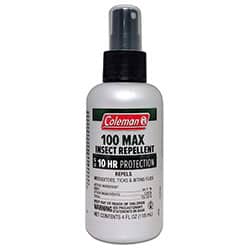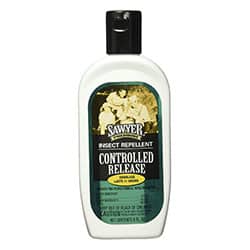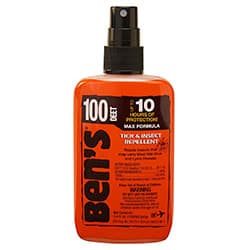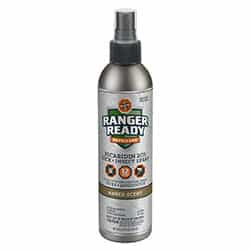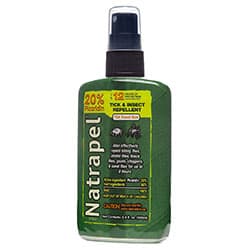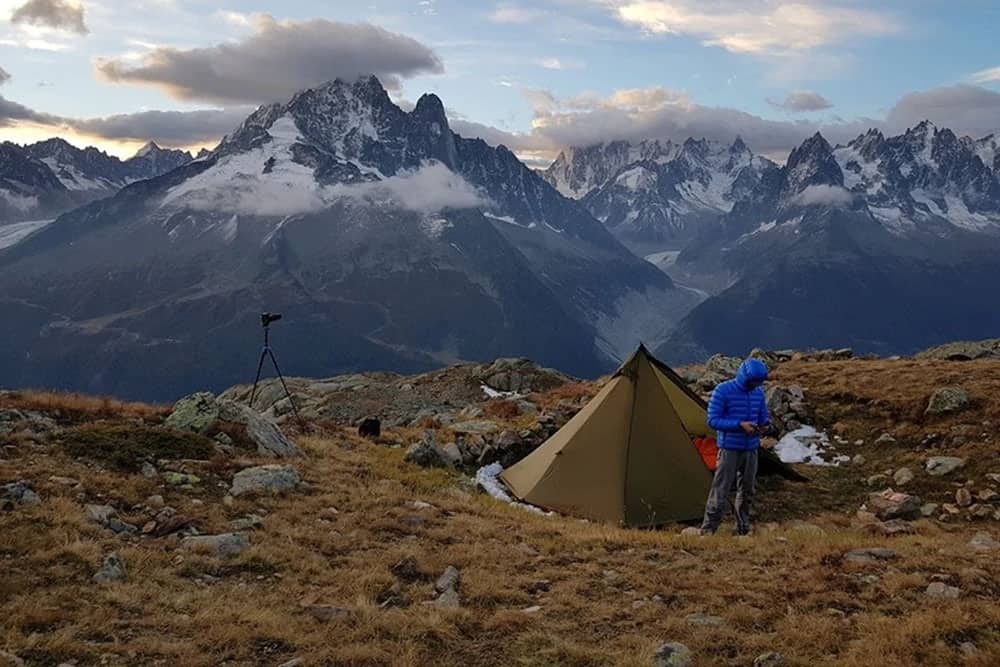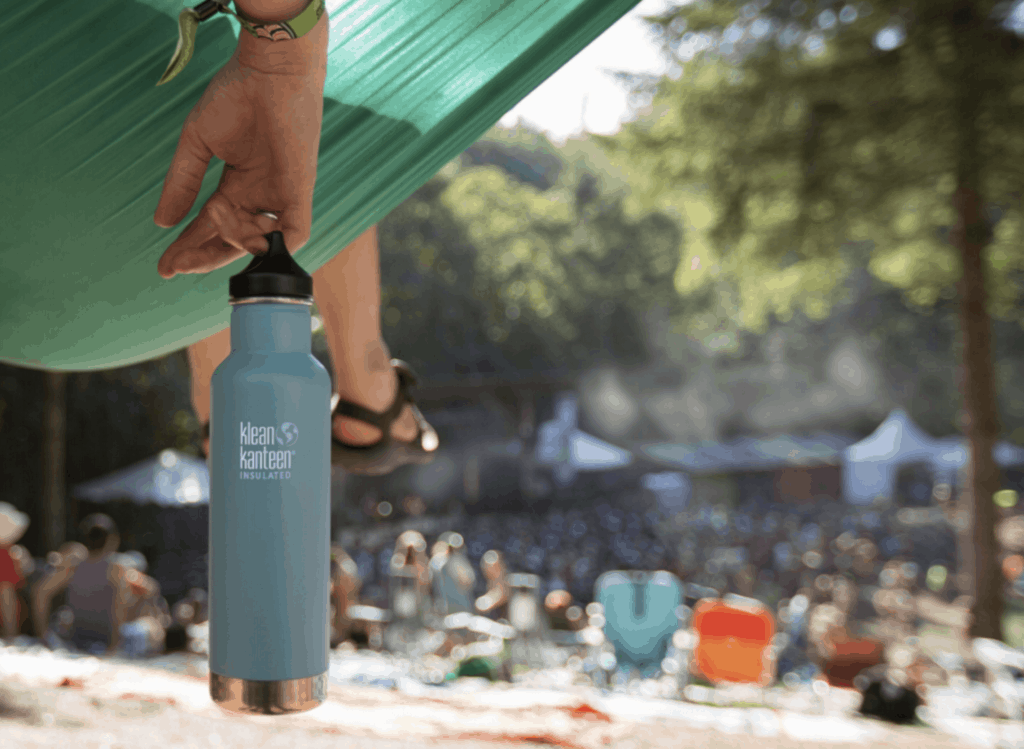Everybody loves the warm weather but nobody loves the mosquitoes that come with it. And that’s understandable. Not only are they a world-class nuisance but their bites create big unattractive itchy welts that sometimes wind up leaving permanent scars.
Worst of all mosquitoes carry a number of dangerous and, in some cases, fatal diseases (1). In order to avoid mosquitoes altogether you’d have to live in a strictly controlled environment 24/7. But since that simply isn’t an option the next best thing is to invest in a good mosquito repellent.
We have the 10 best Mosquito Repellent of 2022 right here.
1. Sawyer Premium Insect Repellent with 20% Picaridin
Since its introduction some 15 years ago Picaridin has gained a reputation for being a highly effective form of mosquito repellent. It’s now the #1 repellent in Europe and is gaining converts in the US and elsewhere at a rapid clip. Sawyer Premium Insect Repellent features 20% picaridin and is highly effective in repelling mosquitoes as well as ticks, chiggers and more.
This is a long-lasting spray repellent that’s good for up to 12 hours. And it doesn’t have the type of chemical odor DEET has which some people find off-putting. Nor will it harm your clothes, backpack, fishing or hunting equipment like DEET can. Sawyer Premium is considered safe for adults and children and the pump spray is environmentally friendly as well.
2. Coleman 100% Max Insect Repellent
Considering their entire business is focused on creating affordable high-quality outdoor gear it should be no surprise that Coleman also produces an outstanding insect repellent. Their 100% Max repels mosquitoes, biting flies, gnats, ticks, deerflies, no-see-ums and more. It’s considered an effective way to prevent malaria, Zika virus, West Nile virus, Dengue fever and Lyme disease.
And it’s high concentration of DEET is certain to keep you bite free for up to 10 full hours. Coleman has put extra effort into mitigating the sometimes unpleasant odor associated with DEET. And they’ve managed to do so without simply burying it beneath some odious perfume smell. This is one of our favorite mosquito repellents for the back country.
3. OFF! Deep Woods Dry Insect Repellent VIII
For many people in post WWII America their first exposure to mosquito repellents came in the form of a can of OFF! Half a century later the company is still producing high-quality mosquito repellents. And the latest version of their Deep Woods line of repellents is maybe their best ever. Deep Woods Dry contains 25% DEET.
Which is enough to keep even the most aggressive insects at bay for hours. The formulation here is non-greasy. So all kinds of dust and dirt isn’t going to stick to your skin after you spray it on. And it’s considered an effective means of repelling mosquitoes that may be carrying malaria, zika and other types of blood borne viruses.
4. Sky Organic Mosquito Repellent
Many folks have an aversion to mosquito repellents that contain DEET. Some are put off by the smell. Others by the fact that it’s the product of a laboratory. Fortunately, these folks can still maintain a high degree of safety from biting mosquitoes by using organic repellents such as this one from Sky Organics.
Sky Organic Mosquito Repellent uses a blend of soybean, castor, citronella, lavender, cedarwood and other oils to produce a reasonably effective, if not terribly long lasting (4 hours), shield against biting insects. We would not recommend this for someone heading into the Everglades or the rain forests of Brazil or Borneo. But for everyday backyard activities and trips to the park it should be more than adequate.
5. Sawyer Insect Repellent Lotion
Sawyer makes a return visit to our list with their controlled-release, non-greasy Insect Repellent Lotion. If the notion of having mosquito spray blow back into your eyes while you’re applying it doesn’t appeal to you Sawyer’s Repellent Lotion may be just what the doctor ordered. It’s easy to apply, doesn’t leave a thick greasy film behind and contains 20% DEET.
That’s enough DEET to scare off even those late-in-the-day mosquito swarms. This insect repellent is odorless and won’t be neutralized by sweat the way some other repellents can be. It’s compatible with sunscreens and a single application should hold you in good stead for up to 11 hours. It’s also surprisingly affordable and safe for the whole family.
6. Ben’s 100% DEET Mosquito, Tick, and Insect Repellent
If you’re traveling to a high risk part of the world or planning on taking a camping, fishing or hunting vacation this summer you’ll want to make sure you have maximum protection from mosquitoes and other biting insects. Ben’s 100% DEET repellent provides that. This is about as close as you’re going to come to foolproof mosquito protection.
As long as you make sure you reapply it thoroughly before it wears off (which usually takes about 10 hours). While it doesn’t actually contain 100% DEET, at 98.1% it’s close enough that we’re not going to argue with them. If you’ve been looking for the perfect repellent to take with you on your next globe-trotting adventure Ben’s 100% is also TSA compliant (2) both in formulation and in size.
7. Ranger Ready Picaridin Insect Repellent
Some experts consider picaridin to be as effective as DEET in fending off biting insects. But while others would argue that point they’ll still acknowledge that it’s no worse than a close second. Ranger Ready Picaridin Insect Repellent contains 20% picaridin, features an effective, environmentally friendly pump spray and goes on without producing a greasy film.
It also has a light amber scent which didn’t do much for us, but which some will no doubt find pleasant enough. Ranger Ready Picaridin provides up to 12 hours of effective protection from mosquitoes and ticks and only slightly less against biting flies, gnats and chiggers. Ranger Ready is considered safe for kids and adults and each can contains up to 70 applications.
8. Coleman 40% DEET Insect Repellent
Coleman is back with their 40% DEET insect repellent. 40% DEET is going to protect you from all but the largest, hungriest swarms of mosquitoes. And even then it will likely ward off most of them. Although this is an aerosol spray it nonetheless goes on dry and is resistant to sweat.
It’s unscented (though it does have something of a DEET scent that’s unavoidable) and it shouldn’t be negatively affected by sunscreen either. The can itself is rust resistant and has a child-resistant twist locking cap. Coleman 40% DEET is considered effective protection against malaria, Zika virus, West Nile virus and Dengue fever. And will also provide ample protection against ticks that carry Lyme disease.
9. REPEL Lemon Eucalyptus Insect Repellent
Repel Lemon Eucalyptus Insect Repellent is another outstanding choice for those seeking a non-chemical answer to the problem of mosquito bites. Lemon eucalyptus is the only plant-based ingredient the CDC recognizes as being an effective mosquito repellent.
Repel Lemon Eucalyptus will provide up to 6 hours of protection from mosquitoes, gnats, chiggers and more. Although it is recommended you opt for DEET or picaridin if traveling to the jungles of Africa, South America or Asia Repel Lemon Eucalyptus should provide more than adequate protection for most other situations.
10. Natrapel 8 Hour Insect Repellent
The final item on our list is Natrapel 8 Hour Insect Repellent. Natrapel contains 20% picaridin which is enough to keep you shielded in all but the most extreme situations. It comes with an environmentally-friendly and effective pump spray, won’t harm your gear like DEET sometimes can and, as the name states, provides up to 8 hours of protection against disease carrying mosquitoes and other insects.
It’s also TSA compliant. So you can take it on your next trip to Thailand without worrying about it.
FAQs
Why do Mosquitoes Bite People?
Mosquitos bite in order to survive. That much is well-known. What isn’t so well known is that only female mosquitos actually bite humans and drink their blood. While males mostly focus their culinary attention on fruit and the occasional dose of plant nectar. Female mosquitos seek out animal blood because they require lots of protein in order to promote healthy egg development.
Another thing that’s necessary for proper development of mosquito eggs is water. And the calmer the better. Which is why you often find yourself being besieged by mosquitos around bodies of water. And why allowing pools of standing water to fester in the yard is not a great idea.
But while mosquitos are big fans of water they’re not so fond of cold weather. When the temperature dips in the fall they seek out a safe place and begin a long hibernation (3). Typically they’ll remain in a state of hibernation until the temperature rises again to about 80 degrees. At which point they shake off the cobwebs from their long winter’s nap and set about trying to ruin your Memorial Day BBQ.
What Diseases Do Mosquitos Carry?
The threat from mosquitos is very real and every year millions are stricken with mosquito-borne diseases. These include:
- Zika Virus – The Zika virus is prevalent throughout South and Central America and arrived in the US in 2016. Shortly afterward a global public health emergency was declared by the WHO. For most people the effects of Zika are considered to be fairly mild – aches and pains, slight fever, conjunctivitis (red eyes) – and most people will either feel nothing or get over it in a matter of weeks. So why the global health emergency? Because the Zika virus can be extremely dangerous to pregnant women (4). If a pregnant women contracts the Zika virus her child may be born with severe birth defects. These include microcephaly, in which the baby has an abnormally small head and may suffer from loss of vision, seizures and mental retardation.
- Malaria – Malaria (5) is one of the most common and dangerous diseases transmitted by mosquitoes. Most people are infected by mosquitoes that have picked up the disease from other humans already infected. Malaria is caused by the parasites plasmodium falciparum and plasmodium vivax. Once ingested by the female mosquito these parasites then spend about 2 weeks developing in their stomach. Once fully developed they are passed on by way of saliva the mosquito emits while feeding on another human. Malaria has been largely (not entirely) eradicated in the US but worldwide it’s estimated there may be up to half a billion cases per year. With most cases occurring in tropical and sub-tropical climates.
- West Nile Virus – While most people infected with West Nile Virus (6) have few if any symptoms and go on with their lives unaffected, others develop a life-threatening condition known as encephalitis. Encephalitis is characterized by inflammation of the brain tissue and in some cases can cause seizures, coma and even death. As the name suggests West Nile Virus is thought to have originated in Africa. But in recent decades it has spread to virtually every part of the world. Including the US.
- Dengue Fever – Dengue fever (7) is another disease that is primarily spread by mosquitoes biting infected people and subsequently passing it to other people they bite. Dengue is a hemorrhagic fever. Early symptoms of infection include joint pain, rashes and fever. But after a week or so the person may start to experience bruising and/or bleeding. About 5 percent of people who contract the disease die from it. At the moment there are no known cures for Dengue fever.
- Yellow Fever – Yellow fever (8) is another disease passed from person to person by the lowly mosquito. Early symptoms of infection include nausea, headaches, fever and chills. However, that’s only the beginning. Because in most cases, after a short lull, much more serious symptoms begin to manifest themselves including stomach cramps, bloody vomit and nosebleeds. In some areas as many as half the people who contract Yellow fever die from the disease. There is no cure for Yellow fever but a vaccine does exist for travellers. Yellow fever is primarily found in tropical regions of Africa and South America.
- Chikungunya – Chikungunya (9) is a little known infectious disease spread by mosquitoes that affects millions of people every year in Asia, South America, Africa and the Caribbean. Symptoms of infection typically take 3 – 7 days to manifest and include back pain, nausea, vomiting and joint pain. In underdeveloped areas where access to healthcare services is poor fatality rates can be as high as 10%.
Protecting yourself from mosquitoes is not something to be taken lightly. Every year millions of people worldwide die and untold millions suffer debilitating illness after being bitten by mosquitos. Make sure you always have a good mosquito repellent with you when you travel or otherwise venture in the outdoors.
What is DEET?
You probably noticed that many of the mosquito repellents on our list rely on a substance called DEET. Those with a lot of outdoor experience may be familiar with this chemical but to others it may seem like a relatively new development. After all, who remembers their moms saying “Don’t forget to use some DEET before you go out!”
The fact is DEET (N,N-diethyl-meta-toluamide – say that 3 times fast) has been a common ingredient in mosquito repellents since the late 1950s. Though it’s only in recent years that manufacturers have begun shouting about its presence from the rooftops. Why the change? Who knows the secrets of the marketer’s heart?
So why do so many mosquito repellents use DEET? Because it’s remarkably effective. The thing is that exactly how it works and why it’s so effective has remained something of a mystery until recently. Research now suggests that DEET acts as a kind of radar jammer that interferes with the odor receptors in the antennae of the mosquito (10). In effect, it acts as a kind of stealth technology, blinding the enemy radar to our presence and allowing us to enjoy our hike through the backcountry without being beset by bloodsuckers.
So DEET is designed to hide us from mosquitoes, not to kill them and it’s considered safe for people and in some cases, pets as well. In fact each year some 1/3 of the US population uses a mosquito or insect repellent that contains DEET.
Do Mosquito Repellents Produce Side Effects?
Here is a look at the possible side effects of the most common ingredients in commercially available mosquito repellents.
DEET Side Effects
After concerns surfaced in the late 90s that DEET may not be safe the EPA undertook an extensive review of decades of public usage of the mosquito repelling chemical. Their research indicated that, when used as directed DEET “does not present a health concern” to humans (11). They did however note that when excessive amounts of DEET are used certain adverse side effects may arise. These include:
- Eye irritation.
- Slurred speech.
- Tremors.
It must be noted however, that these effects were only manifested in people who had exposed themselves to many times the recommended amount of DEET. Normal use is considered safe by the EPA, the CDC, AMA and WHO.
Picaridin Side Effects
Picaridin is another very popular ingredient in insect repellents. It is considered basically safe for use by humans with reports of adverse side effects being very rare. Picaridin is a synthetic substance (12) that mimics the properties of piperine, the active component in black pepper. While the vast majority of people will suffer no ill effects from using repellents that contain picaridin, some with hypersensitive skin may develop red, itchy patches. If the application of picaridin causes uncomfortable feelings it’s recommended you wash it off immediately and seek another type of mosquito repellent.
Lemon Eucalyptus Oil Side Effects
Lemon eucalyptus oil is considered safe for both adults and children when applied as part of mosquito repellent formula. However, it must be noted that although the name sounds harmless and perhaps even inviting, ingesting lemon eucalyptus oil can prove fatal.
Is There Any Way to Reduce the Risk of Being Bitten?
Besides availing yourself of one of the high-quality mosquito repellents on our list there are some other steps you can take to reduce the risk that you’ll be bitten by mosquitoes. These include:
- Covering up – If you are venturing into areas where you know or suspect you’ll encounter large numbers of mosquitoes it’s recommended you cover up using light-color clothes. Long sleeve shirts can be very helpful and you should think twice about wearing shorts in high risk areas.
- Draining any standing water – If there are areas of standing water on your property it’s in your interest to have them drained and take whatever steps necessary to prevent them from filling up again. If you have a water feature in your yard like a fountain or man-made waterfall try surrounding it with mint, jasmine or lavender. These plants are known to repel mosquitoes.
- Keeping the screen closed – Many people get complacent when camping and in the spirit of kicking back they’ll leave the screen door open on their tent. During the twilight hours in particular this can be a big mistake. Malaria carrying mosquitoes in particular tend to be active during the hours of dawn and dusk (13).
The Bottom Line
There is no way to calculate how many lives have been saved by the modern mosquito repellent. But in the half century since they’ve become popular the number must be in the millions. And that doesn’t account for the many million more cases of low level infections that never occurred because people slathered on the mosquito repellent before they went out. Don’t become a victim of your own negligence. Always have a quality mosquito repellent with you when traveling, camping, hiking, hunting, fishing or just lounging in the yard.

